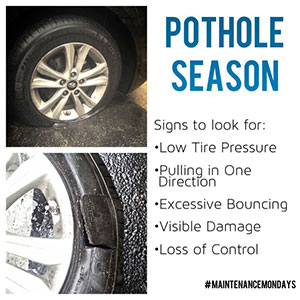Potholes: They’re Back And They’re Bad
by schearerswpadmin March 31, 2015Potholes have returned, and hitting one with your car can do a real number on tires, wheels, steering and suspension, and alignment. To help determine if hitting a pothole has damaged your vehicle, the Car Care Council reminds you to watch for these warning signs:
Loss of control, swaying when making routine turns, bottoming out on city streets or bouncing excessively on rough roads are indicators that the steering and suspension may have been damaged. The steering and suspension are key safety-related systems. Together, they largely determine your car’s ride and handling. Key components are shocks and/or struts, the steering knuckle, ball joints, the steering rack/box, bearings, seals and hub units and tie rod ends.
Pulling in one direction, instead of maintaining a straight path, and uneven tire wear, are symptoms of an alignment problem. Proper wheel alignment is important for the lifespan of tires and helps ensure safe handling.
Low tire pressure, bulges or blisters on the sidewalls, or dents in the wheel rim will be visible and should be checked out as soon as possible, as tires are the critical connection between your car and the road.
Pothole season- signs to look for“Don’t look now, but you’re probably about to hit another pothole,” said Rich White, executive director, Car Care Council. “If you’ve hit a pothole, it can be difficult to know if your vehicle has been damaged in the process. Have a professional technician check out the car and make the necessary repairs to ensure safety and reliability.”
Potholes occur when water permeates the pavement – usually through a crack – and softens the soil beneath it, creating a depression in the surface of the street. Many potholes appear during winter and spring months because of freeze-thaw cycles, which accelerate the process. Potholes can also be prevalent in areas with excessive rainfall and flooding.
The Car Care Council is the source of information for the “Be Car Care Aware” consumer education campaign promoting the benefits of regular vehicle care, maintenance and repair to consumers. For a copy of the council’s Car Care Guide or for more information, visit www.carcare.org.





